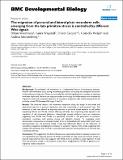| dc.contributor.author | Sweetman, Dylan | |
| dc.contributor.author | Wagstaff, Laura | |
| dc.contributor.author | Cooper, Oliver Jamie | |
| dc.contributor.author | Weijer, Cornelis | |
| dc.contributor.author | Münsterberg, Andrea | |
| dc.date.accessioned | 2011-03-27T19:39:37Z | |
| dc.date.issued | 2008 | |
| dc.identifier.citation | Sweetman, Dylan, Laura Wagstaff, Oliver Cooper, Cornelis Weijer, and Andrea Münsterberg. 2008. The migration of paraxial and lateral plate mesoderm cells emerging from the late primitive streak is controlled by different Wnt signals. BMC Developmental Biology 8: 63. | en_US |
| dc.identifier.issn | 1471-213X | en_US |
| dc.identifier.uri | http://nrs.harvard.edu/urn-3:HUL.InstRepos:4774184 | |
| dc.description.abstract | Background: Co-ordinated cell movement is a fundamental feature of developing embryos. Massive cell movements occur during vertebrate gastrulation and during the subsequent extension of the embryonic body axis. These are controlled by cell-cell signalling and a number of pathways have been implicated. Here we use long-term video microscopy in chicken embryos to visualize the migration routes and movement behaviour of mesoderm progenitor cells as they emerge from the primitive streak (PS) between HH stages 7 and 10. Results: We observed distinct cell movement behaviours along the length of the streak and determined that this is position dependent with cells responding to environmental cues. The behaviour of cells was altered by exposing embryos or primitive streak explants to cell pellets expressing Wnt3a and Wnt5a, without affecting cell fates, thus implicating these ligands in the regulation of cell movement behaviour. Interestingly younger embryos were not responsive, suggesting that Wnt3a and Wnt5a are specifically involved in the generation of posterior mesoderm, consistent with existing mouse and zebrafish mutants. To investigate which downstream components are involved mutant forms of dishevelled (dsh) and prickle1 (pk1) were electroporated into the primitive streak. These had differential effects on the behaviour of mesoderm progenitors emerging from anterior or posterior regions of the streak, suggesting that multiple Wnt pathways are involved in controlling cell migration during extension of the body axis in amniote embryos. Conclusion: We suggest that the distinct behaviours of paraxial and lateral mesoderm precursors are regulated by the opposing actions of Wnt5a and Wnt3a as they leave the primitive streak in neurula stage embryos. Our data suggests that Wnt5a acts via prickle to cause migration of cells from the posterior streak. In the anterior streak, this is antagonised by Wnt3a to generate non-migratory medial mesoderm. | en_US |
| dc.language.iso | en_US | en_US |
| dc.publisher | BioMed Central | en_US |
| dc.relation.isversionof | doi:10.1186/1471-213X-8-63 | en_US |
| dc.relation.hasversion | http://www.ncbi.nlm.nih.gov/pmc/articles/PMC2435575/pdf/ | en_US |
| dash.license | LAA | |
| dc.title | The Migration of Paraxial and Lateral Plate Mesoderm Cells Emerging from the Late Primitive Streak is Controlled by Different Wnt Signals | en_US |
| dc.type | Journal Article | en_US |
| dc.description.version | Version of Record | en_US |
| dc.relation.journal | BMC Developmental Biology | en_US |
| dash.depositing.author | Cooper, Oliver Jamie | |
| dc.date.available | 2011-03-27T19:39:37Z | |
| dash.affiliation.other | HMS^Psychiatry-McLean Hospital | en_US |
| dc.identifier.doi | 10.1186/1471-213X-8-63 | * |
| dash.contributor.affiliated | Cooper, Oliver Jamie | |


